A Comprehensive Report on Compliance Management for Charity Care
VerifiedAdded on 2022/08/17
|10
|2169
|18
Report
AI Summary
This report provides a comprehensive analysis of the compliance management system for Charity Care, a case study involving financial irregularities and operational inefficiencies. The research plan outlines the assessment of legislative requirements, employing survey tools like open-ended questionnaires, interviews, and direct observation to gather qualitative and quantitative data. The report details internal compliance policies concerning financial handling and expense reimbursement, as well as external compliance requirements based on Australian standards for record management and risk management. It identifies industry-specific compliance needs and assesses the impact of non-compliance, including financial fraud, risks, and penalties. The report recommends replacing the current CEO, hiring a qualified bookkeeper, and improving management in the retail store and warehouse to ensure ongoing compliance and improve organizational performance. The research methodology includes using survey tools to capture organizational data, collection of compliance performance data, internal compliance organizational policy and procedure documents, external compliance, and industry-specific compliance requirement. The report concludes with recommendations for improving the compliance management system and reflects on the research process.
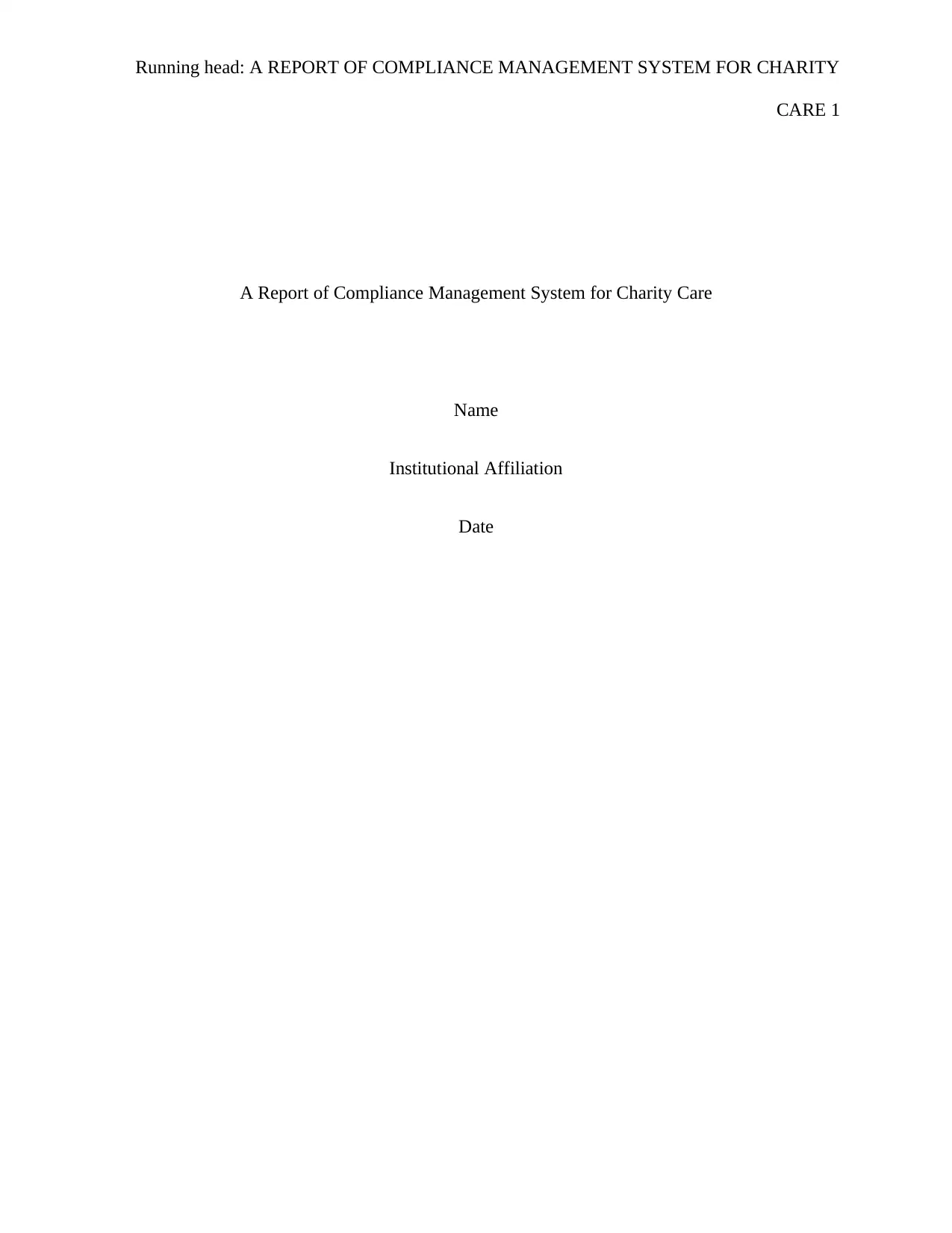
Running head: A REPORT OF COMPLIANCE MANAGEMENT SYSTEM FOR CHARITY
CARE 1
A Report of Compliance Management System for Charity Care
Name
Institutional Affiliation
Date
CARE 1
A Report of Compliance Management System for Charity Care
Name
Institutional Affiliation
Date
Paraphrase This Document
Need a fresh take? Get an instant paraphrase of this document with our AI Paraphraser
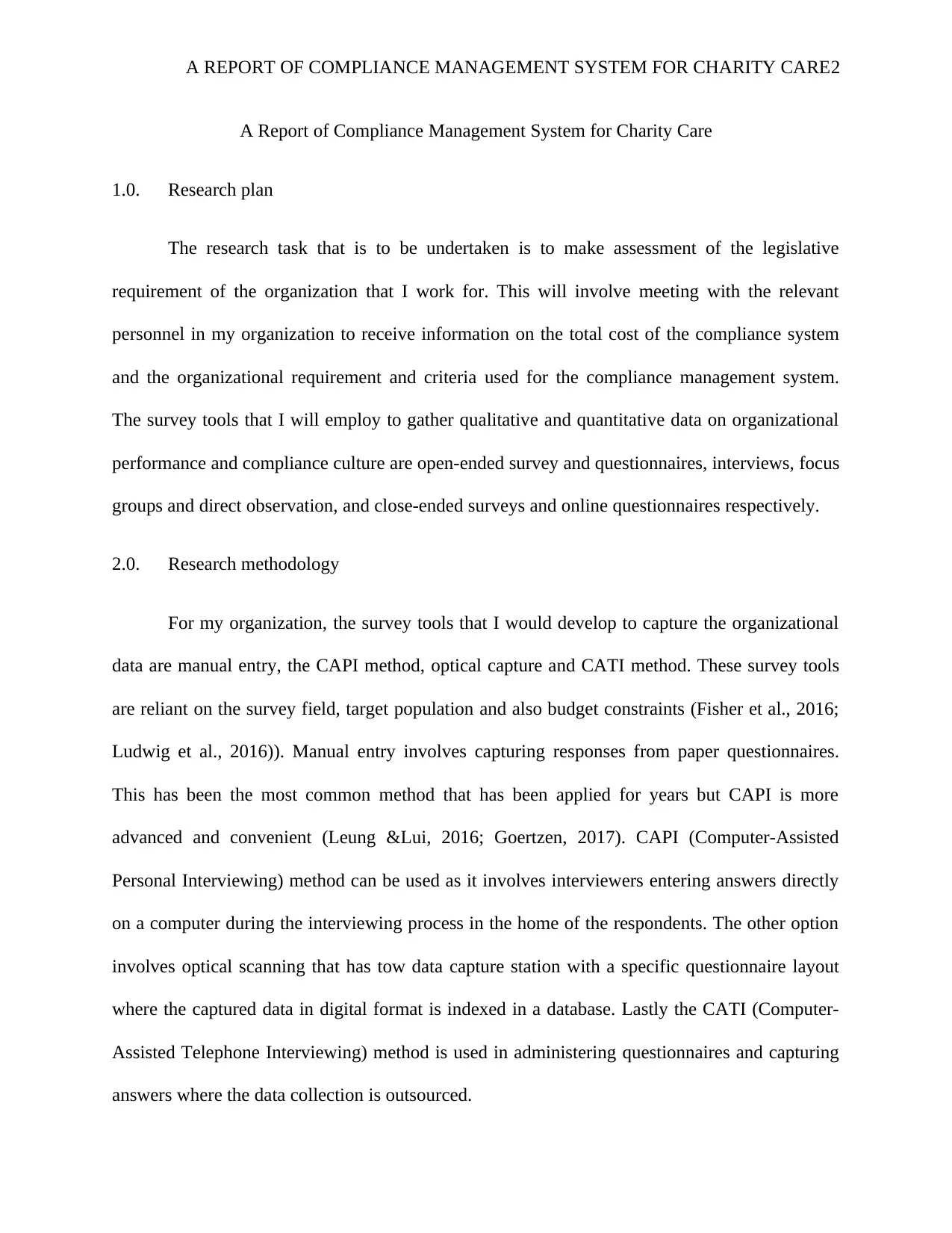
A REPORT OF COMPLIANCE MANAGEMENT SYSTEM FOR CHARITY CARE2
A Report of Compliance Management System for Charity Care
1.0. Research plan
The research task that is to be undertaken is to make assessment of the legislative
requirement of the organization that I work for. This will involve meeting with the relevant
personnel in my organization to receive information on the total cost of the compliance system
and the organizational requirement and criteria used for the compliance management system.
The survey tools that I will employ to gather qualitative and quantitative data on organizational
performance and compliance culture are open-ended survey and questionnaires, interviews, focus
groups and direct observation, and close-ended surveys and online questionnaires respectively.
2.0. Research methodology
For my organization, the survey tools that I would develop to capture the organizational
data are manual entry, the CAPI method, optical capture and CATI method. These survey tools
are reliant on the survey field, target population and also budget constraints (Fisher et al., 2016;
Ludwig et al., 2016)). Manual entry involves capturing responses from paper questionnaires.
This has been the most common method that has been applied for years but CAPI is more
advanced and convenient (Leung &Lui, 2016; Goertzen, 2017). CAPI (Computer-Assisted
Personal Interviewing) method can be used as it involves interviewers entering answers directly
on a computer during the interviewing process in the home of the respondents. The other option
involves optical scanning that has tow data capture station with a specific questionnaire layout
where the captured data in digital format is indexed in a database. Lastly the CATI (Computer-
Assisted Telephone Interviewing) method is used in administering questionnaires and capturing
answers where the data collection is outsourced.
A Report of Compliance Management System for Charity Care
1.0. Research plan
The research task that is to be undertaken is to make assessment of the legislative
requirement of the organization that I work for. This will involve meeting with the relevant
personnel in my organization to receive information on the total cost of the compliance system
and the organizational requirement and criteria used for the compliance management system.
The survey tools that I will employ to gather qualitative and quantitative data on organizational
performance and compliance culture are open-ended survey and questionnaires, interviews, focus
groups and direct observation, and close-ended surveys and online questionnaires respectively.
2.0. Research methodology
For my organization, the survey tools that I would develop to capture the organizational
data are manual entry, the CAPI method, optical capture and CATI method. These survey tools
are reliant on the survey field, target population and also budget constraints (Fisher et al., 2016;
Ludwig et al., 2016)). Manual entry involves capturing responses from paper questionnaires.
This has been the most common method that has been applied for years but CAPI is more
advanced and convenient (Leung &Lui, 2016; Goertzen, 2017). CAPI (Computer-Assisted
Personal Interviewing) method can be used as it involves interviewers entering answers directly
on a computer during the interviewing process in the home of the respondents. The other option
involves optical scanning that has tow data capture station with a specific questionnaire layout
where the captured data in digital format is indexed in a database. Lastly the CATI (Computer-
Assisted Telephone Interviewing) method is used in administering questionnaires and capturing
answers where the data collection is outsourced.
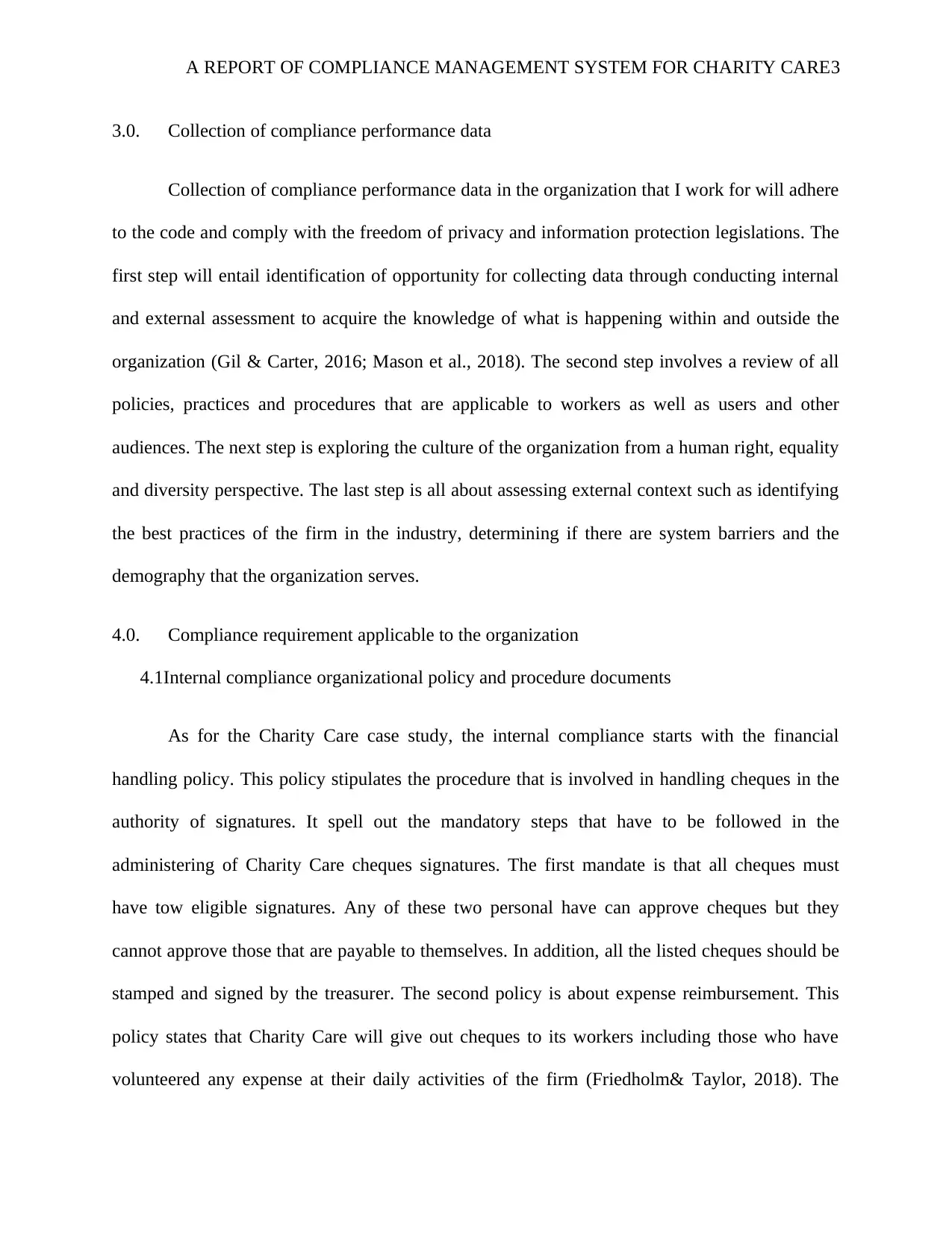
A REPORT OF COMPLIANCE MANAGEMENT SYSTEM FOR CHARITY CARE3
3.0. Collection of compliance performance data
Collection of compliance performance data in the organization that I work for will adhere
to the code and comply with the freedom of privacy and information protection legislations. The
first step will entail identification of opportunity for collecting data through conducting internal
and external assessment to acquire the knowledge of what is happening within and outside the
organization (Gil & Carter, 2016; Mason et al., 2018). The second step involves a review of all
policies, practices and procedures that are applicable to workers as well as users and other
audiences. The next step is exploring the culture of the organization from a human right, equality
and diversity perspective. The last step is all about assessing external context such as identifying
the best practices of the firm in the industry, determining if there are system barriers and the
demography that the organization serves.
4.0. Compliance requirement applicable to the organization
4.1Internal compliance organizational policy and procedure documents
As for the Charity Care case study, the internal compliance starts with the financial
handling policy. This policy stipulates the procedure that is involved in handling cheques in the
authority of signatures. It spell out the mandatory steps that have to be followed in the
administering of Charity Care cheques signatures. The first mandate is that all cheques must
have tow eligible signatures. Any of these two personal have can approve cheques but they
cannot approve those that are payable to themselves. In addition, all the listed cheques should be
stamped and signed by the treasurer. The second policy is about expense reimbursement. This
policy states that Charity Care will give out cheques to its workers including those who have
volunteered any expense at their daily activities of the firm (Friedholm& Taylor, 2018). The
3.0. Collection of compliance performance data
Collection of compliance performance data in the organization that I work for will adhere
to the code and comply with the freedom of privacy and information protection legislations. The
first step will entail identification of opportunity for collecting data through conducting internal
and external assessment to acquire the knowledge of what is happening within and outside the
organization (Gil & Carter, 2016; Mason et al., 2018). The second step involves a review of all
policies, practices and procedures that are applicable to workers as well as users and other
audiences. The next step is exploring the culture of the organization from a human right, equality
and diversity perspective. The last step is all about assessing external context such as identifying
the best practices of the firm in the industry, determining if there are system barriers and the
demography that the organization serves.
4.0. Compliance requirement applicable to the organization
4.1Internal compliance organizational policy and procedure documents
As for the Charity Care case study, the internal compliance starts with the financial
handling policy. This policy stipulates the procedure that is involved in handling cheques in the
authority of signatures. It spell out the mandatory steps that have to be followed in the
administering of Charity Care cheques signatures. The first mandate is that all cheques must
have tow eligible signatures. Any of these two personal have can approve cheques but they
cannot approve those that are payable to themselves. In addition, all the listed cheques should be
stamped and signed by the treasurer. The second policy is about expense reimbursement. This
policy states that Charity Care will give out cheques to its workers including those who have
volunteered any expense at their daily activities of the firm (Friedholm& Taylor, 2018). The
⊘ This is a preview!⊘
Do you want full access?
Subscribe today to unlock all pages.

Trusted by 1+ million students worldwide
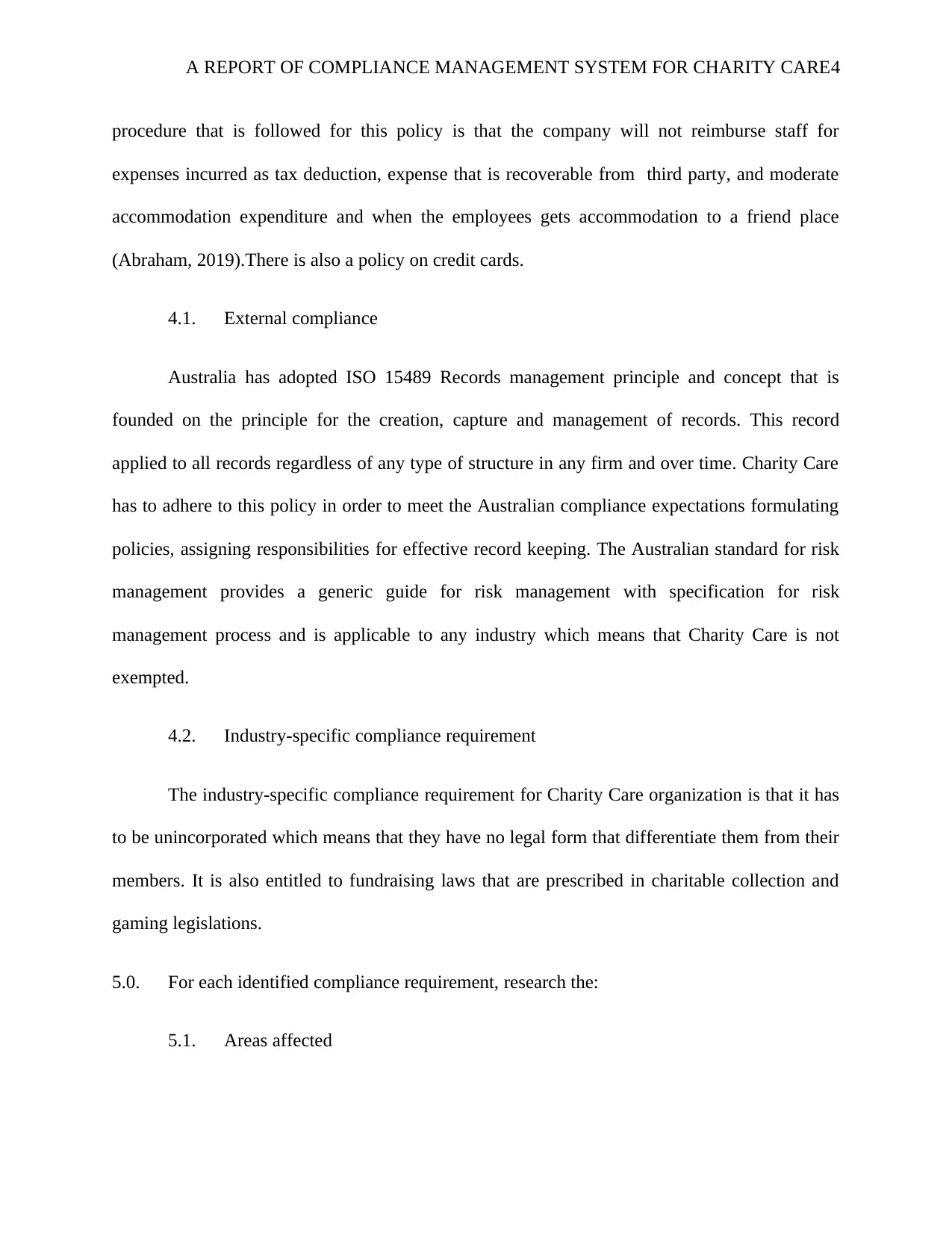
A REPORT OF COMPLIANCE MANAGEMENT SYSTEM FOR CHARITY CARE4
procedure that is followed for this policy is that the company will not reimburse staff for
expenses incurred as tax deduction, expense that is recoverable from third party, and moderate
accommodation expenditure and when the employees gets accommodation to a friend place
(Abraham, 2019).There is also a policy on credit cards.
4.1. External compliance
Australia has adopted ISO 15489 Records management principle and concept that is
founded on the principle for the creation, capture and management of records. This record
applied to all records regardless of any type of structure in any firm and over time. Charity Care
has to adhere to this policy in order to meet the Australian compliance expectations formulating
policies, assigning responsibilities for effective record keeping. The Australian standard for risk
management provides a generic guide for risk management with specification for risk
management process and is applicable to any industry which means that Charity Care is not
exempted.
4.2. Industry-specific compliance requirement
The industry-specific compliance requirement for Charity Care organization is that it has
to be unincorporated which means that they have no legal form that differentiate them from their
members. It is also entitled to fundraising laws that are prescribed in charitable collection and
gaming legislations.
5.0. For each identified compliance requirement, research the:
5.1. Areas affected
procedure that is followed for this policy is that the company will not reimburse staff for
expenses incurred as tax deduction, expense that is recoverable from third party, and moderate
accommodation expenditure and when the employees gets accommodation to a friend place
(Abraham, 2019).There is also a policy on credit cards.
4.1. External compliance
Australia has adopted ISO 15489 Records management principle and concept that is
founded on the principle for the creation, capture and management of records. This record
applied to all records regardless of any type of structure in any firm and over time. Charity Care
has to adhere to this policy in order to meet the Australian compliance expectations formulating
policies, assigning responsibilities for effective record keeping. The Australian standard for risk
management provides a generic guide for risk management with specification for risk
management process and is applicable to any industry which means that Charity Care is not
exempted.
4.2. Industry-specific compliance requirement
The industry-specific compliance requirement for Charity Care organization is that it has
to be unincorporated which means that they have no legal form that differentiate them from their
members. It is also entitled to fundraising laws that are prescribed in charitable collection and
gaming legislations.
5.0. For each identified compliance requirement, research the:
5.1. Areas affected
Paraphrase This Document
Need a fresh take? Get an instant paraphrase of this document with our AI Paraphraser
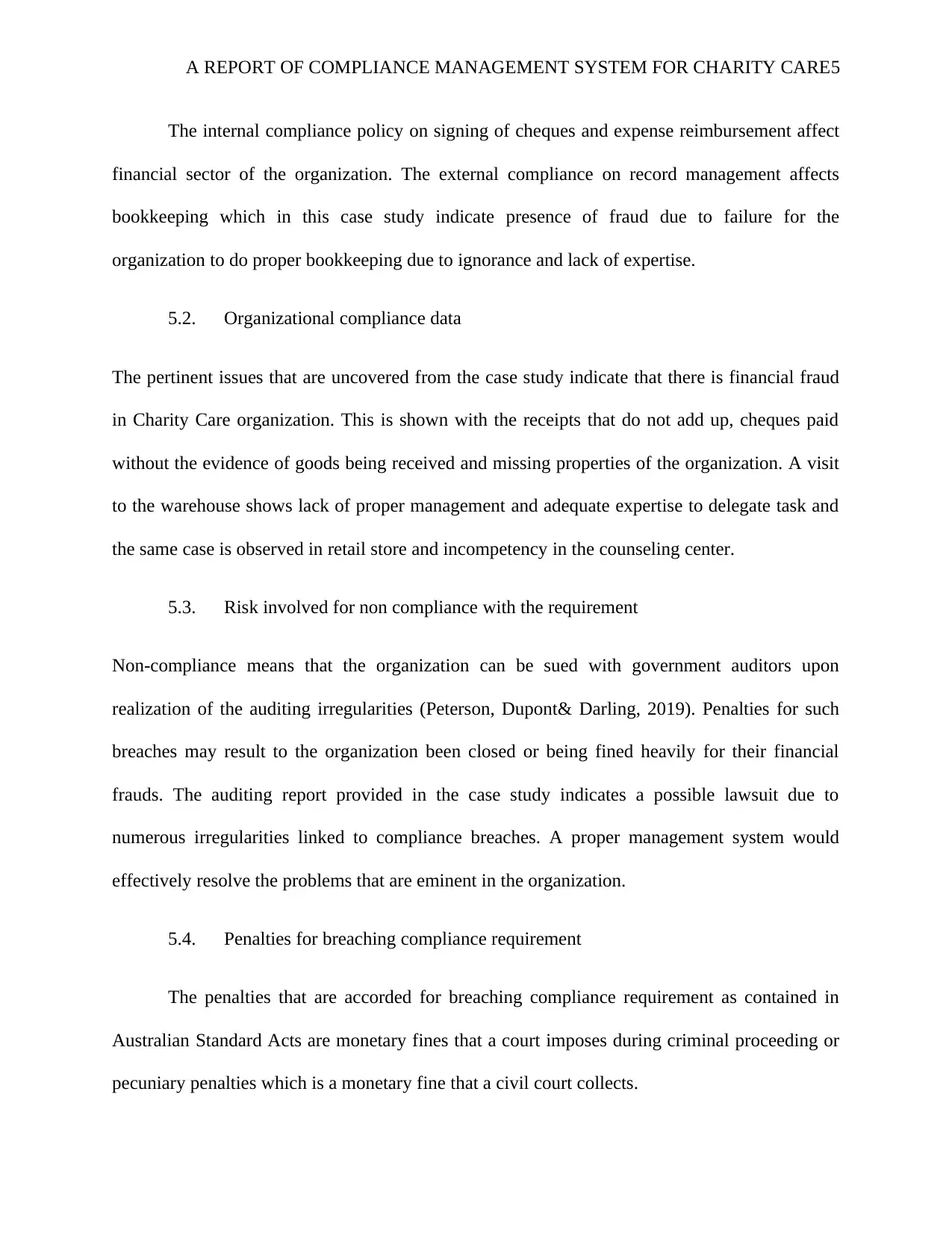
A REPORT OF COMPLIANCE MANAGEMENT SYSTEM FOR CHARITY CARE5
The internal compliance policy on signing of cheques and expense reimbursement affect
financial sector of the organization. The external compliance on record management affects
bookkeeping which in this case study indicate presence of fraud due to failure for the
organization to do proper bookkeeping due to ignorance and lack of expertise.
5.2. Organizational compliance data
The pertinent issues that are uncovered from the case study indicate that there is financial fraud
in Charity Care organization. This is shown with the receipts that do not add up, cheques paid
without the evidence of goods being received and missing properties of the organization. A visit
to the warehouse shows lack of proper management and adequate expertise to delegate task and
the same case is observed in retail store and incompetency in the counseling center.
5.3. Risk involved for non compliance with the requirement
Non-compliance means that the organization can be sued with government auditors upon
realization of the auditing irregularities (Peterson, Dupont& Darling, 2019). Penalties for such
breaches may result to the organization been closed or being fined heavily for their financial
frauds. The auditing report provided in the case study indicates a possible lawsuit due to
numerous irregularities linked to compliance breaches. A proper management system would
effectively resolve the problems that are eminent in the organization.
5.4. Penalties for breaching compliance requirement
The penalties that are accorded for breaching compliance requirement as contained in
Australian Standard Acts are monetary fines that a court imposes during criminal proceeding or
pecuniary penalties which is a monetary fine that a civil court collects.
The internal compliance policy on signing of cheques and expense reimbursement affect
financial sector of the organization. The external compliance on record management affects
bookkeeping which in this case study indicate presence of fraud due to failure for the
organization to do proper bookkeeping due to ignorance and lack of expertise.
5.2. Organizational compliance data
The pertinent issues that are uncovered from the case study indicate that there is financial fraud
in Charity Care organization. This is shown with the receipts that do not add up, cheques paid
without the evidence of goods being received and missing properties of the organization. A visit
to the warehouse shows lack of proper management and adequate expertise to delegate task and
the same case is observed in retail store and incompetency in the counseling center.
5.3. Risk involved for non compliance with the requirement
Non-compliance means that the organization can be sued with government auditors upon
realization of the auditing irregularities (Peterson, Dupont& Darling, 2019). Penalties for such
breaches may result to the organization been closed or being fined heavily for their financial
frauds. The auditing report provided in the case study indicates a possible lawsuit due to
numerous irregularities linked to compliance breaches. A proper management system would
effectively resolve the problems that are eminent in the organization.
5.4. Penalties for breaching compliance requirement
The penalties that are accorded for breaching compliance requirement as contained in
Australian Standard Acts are monetary fines that a court imposes during criminal proceeding or
pecuniary penalties which is a monetary fine that a civil court collects.
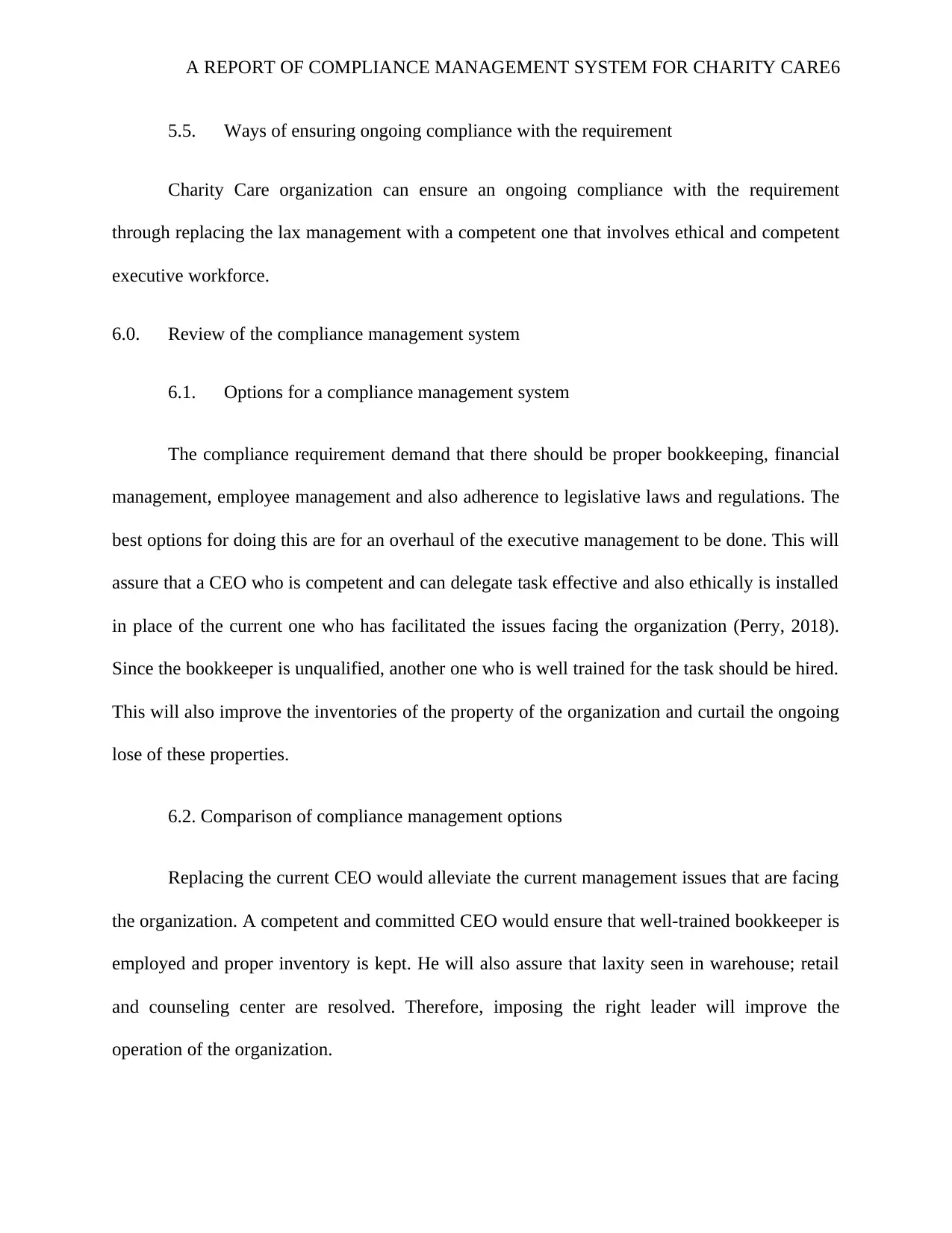
A REPORT OF COMPLIANCE MANAGEMENT SYSTEM FOR CHARITY CARE6
5.5. Ways of ensuring ongoing compliance with the requirement
Charity Care organization can ensure an ongoing compliance with the requirement
through replacing the lax management with a competent one that involves ethical and competent
executive workforce.
6.0. Review of the compliance management system
6.1. Options for a compliance management system
The compliance requirement demand that there should be proper bookkeeping, financial
management, employee management and also adherence to legislative laws and regulations. The
best options for doing this are for an overhaul of the executive management to be done. This will
assure that a CEO who is competent and can delegate task effective and also ethically is installed
in place of the current one who has facilitated the issues facing the organization (Perry, 2018).
Since the bookkeeper is unqualified, another one who is well trained for the task should be hired.
This will also improve the inventories of the property of the organization and curtail the ongoing
lose of these properties.
6.2. Comparison of compliance management options
Replacing the current CEO would alleviate the current management issues that are facing
the organization. A competent and committed CEO would ensure that well-trained bookkeeper is
employed and proper inventory is kept. He will also assure that laxity seen in warehouse; retail
and counseling center are resolved. Therefore, imposing the right leader will improve the
operation of the organization.
5.5. Ways of ensuring ongoing compliance with the requirement
Charity Care organization can ensure an ongoing compliance with the requirement
through replacing the lax management with a competent one that involves ethical and competent
executive workforce.
6.0. Review of the compliance management system
6.1. Options for a compliance management system
The compliance requirement demand that there should be proper bookkeeping, financial
management, employee management and also adherence to legislative laws and regulations. The
best options for doing this are for an overhaul of the executive management to be done. This will
assure that a CEO who is competent and can delegate task effective and also ethically is installed
in place of the current one who has facilitated the issues facing the organization (Perry, 2018).
Since the bookkeeper is unqualified, another one who is well trained for the task should be hired.
This will also improve the inventories of the property of the organization and curtail the ongoing
lose of these properties.
6.2. Comparison of compliance management options
Replacing the current CEO would alleviate the current management issues that are facing
the organization. A competent and committed CEO would ensure that well-trained bookkeeper is
employed and proper inventory is kept. He will also assure that laxity seen in warehouse; retail
and counseling center are resolved. Therefore, imposing the right leader will improve the
operation of the organization.
⊘ This is a preview!⊘
Do you want full access?
Subscribe today to unlock all pages.

Trusted by 1+ million students worldwide
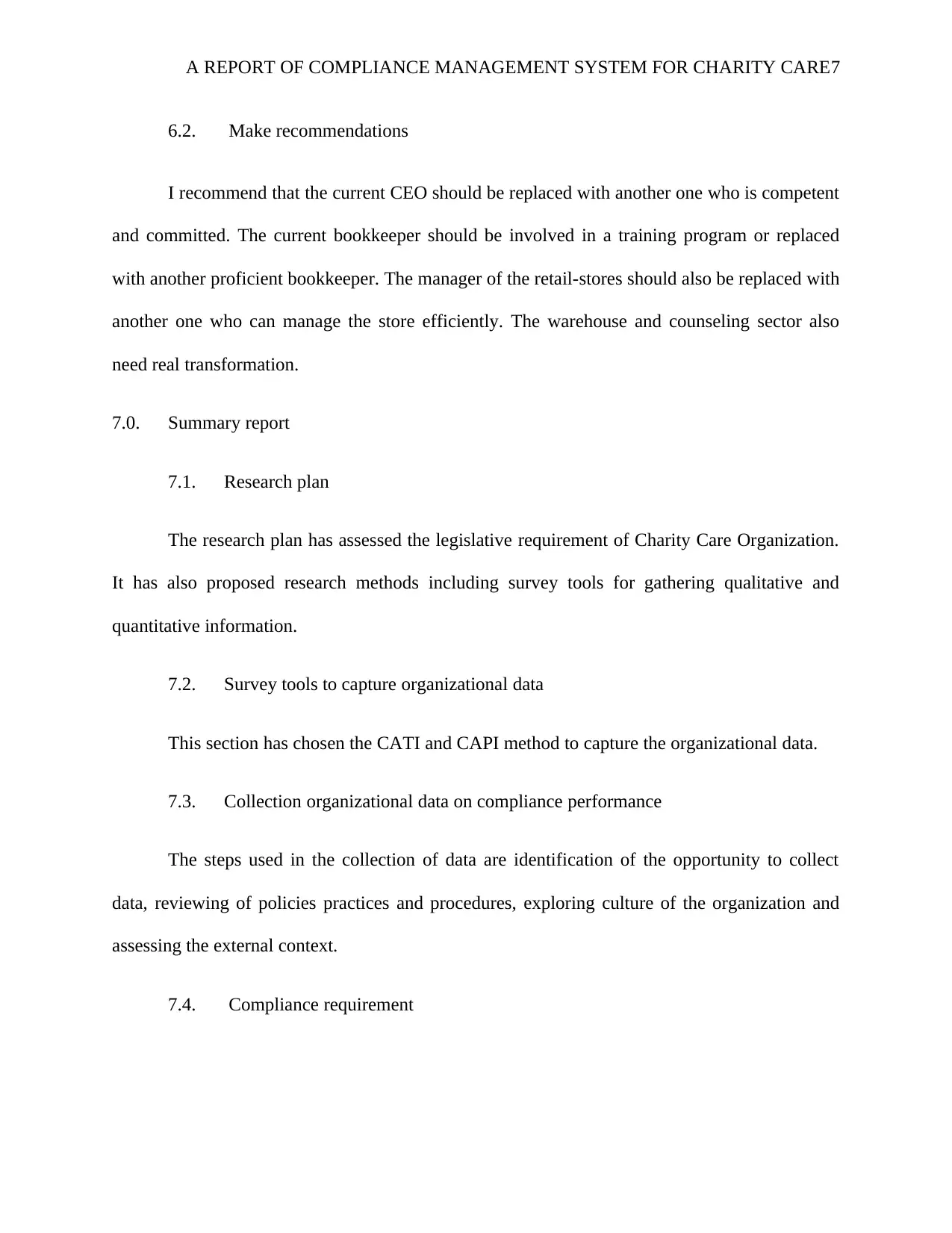
A REPORT OF COMPLIANCE MANAGEMENT SYSTEM FOR CHARITY CARE7
6.2. Make recommendations
I recommend that the current CEO should be replaced with another one who is competent
and committed. The current bookkeeper should be involved in a training program or replaced
with another proficient bookkeeper. The manager of the retail-stores should also be replaced with
another one who can manage the store efficiently. The warehouse and counseling sector also
need real transformation.
7.0. Summary report
7.1. Research plan
The research plan has assessed the legislative requirement of Charity Care Organization.
It has also proposed research methods including survey tools for gathering qualitative and
quantitative information.
7.2. Survey tools to capture organizational data
This section has chosen the CATI and CAPI method to capture the organizational data.
7.3. Collection organizational data on compliance performance
The steps used in the collection of data are identification of the opportunity to collect
data, reviewing of policies practices and procedures, exploring culture of the organization and
assessing the external context.
7.4. Compliance requirement
6.2. Make recommendations
I recommend that the current CEO should be replaced with another one who is competent
and committed. The current bookkeeper should be involved in a training program or replaced
with another proficient bookkeeper. The manager of the retail-stores should also be replaced with
another one who can manage the store efficiently. The warehouse and counseling sector also
need real transformation.
7.0. Summary report
7.1. Research plan
The research plan has assessed the legislative requirement of Charity Care Organization.
It has also proposed research methods including survey tools for gathering qualitative and
quantitative information.
7.2. Survey tools to capture organizational data
This section has chosen the CATI and CAPI method to capture the organizational data.
7.3. Collection organizational data on compliance performance
The steps used in the collection of data are identification of the opportunity to collect
data, reviewing of policies practices and procedures, exploring culture of the organization and
assessing the external context.
7.4. Compliance requirement
Paraphrase This Document
Need a fresh take? Get an instant paraphrase of this document with our AI Paraphraser
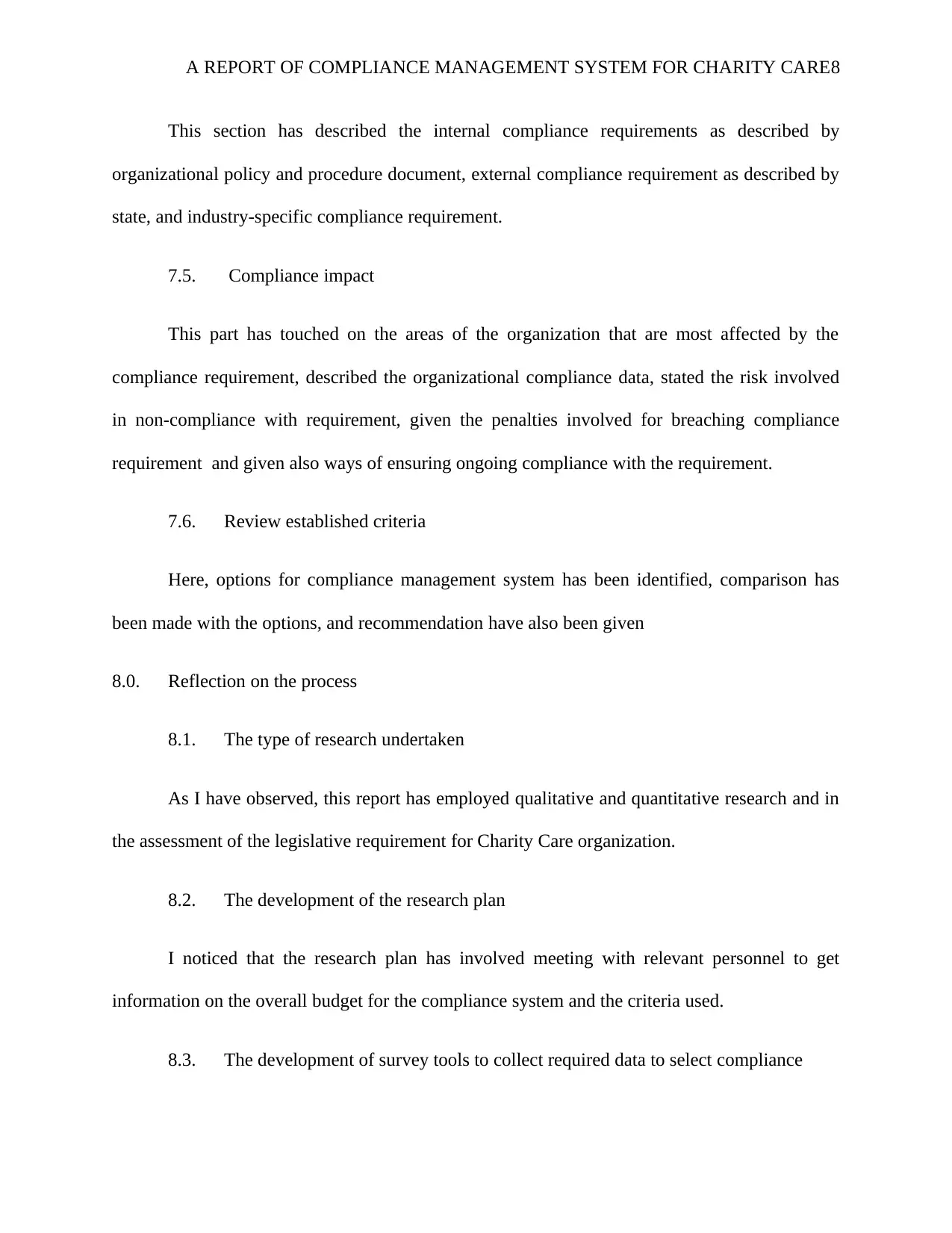
A REPORT OF COMPLIANCE MANAGEMENT SYSTEM FOR CHARITY CARE8
This section has described the internal compliance requirements as described by
organizational policy and procedure document, external compliance requirement as described by
state, and industry-specific compliance requirement.
7.5. Compliance impact
This part has touched on the areas of the organization that are most affected by the
compliance requirement, described the organizational compliance data, stated the risk involved
in non-compliance with requirement, given the penalties involved for breaching compliance
requirement and given also ways of ensuring ongoing compliance with the requirement.
7.6. Review established criteria
Here, options for compliance management system has been identified, comparison has
been made with the options, and recommendation have also been given
8.0. Reflection on the process
8.1. The type of research undertaken
As I have observed, this report has employed qualitative and quantitative research and in
the assessment of the legislative requirement for Charity Care organization.
8.2. The development of the research plan
I noticed that the research plan has involved meeting with relevant personnel to get
information on the overall budget for the compliance system and the criteria used.
8.3. The development of survey tools to collect required data to select compliance
This section has described the internal compliance requirements as described by
organizational policy and procedure document, external compliance requirement as described by
state, and industry-specific compliance requirement.
7.5. Compliance impact
This part has touched on the areas of the organization that are most affected by the
compliance requirement, described the organizational compliance data, stated the risk involved
in non-compliance with requirement, given the penalties involved for breaching compliance
requirement and given also ways of ensuring ongoing compliance with the requirement.
7.6. Review established criteria
Here, options for compliance management system has been identified, comparison has
been made with the options, and recommendation have also been given
8.0. Reflection on the process
8.1. The type of research undertaken
As I have observed, this report has employed qualitative and quantitative research and in
the assessment of the legislative requirement for Charity Care organization.
8.2. The development of the research plan
I noticed that the research plan has involved meeting with relevant personnel to get
information on the overall budget for the compliance system and the criteria used.
8.3. The development of survey tools to collect required data to select compliance
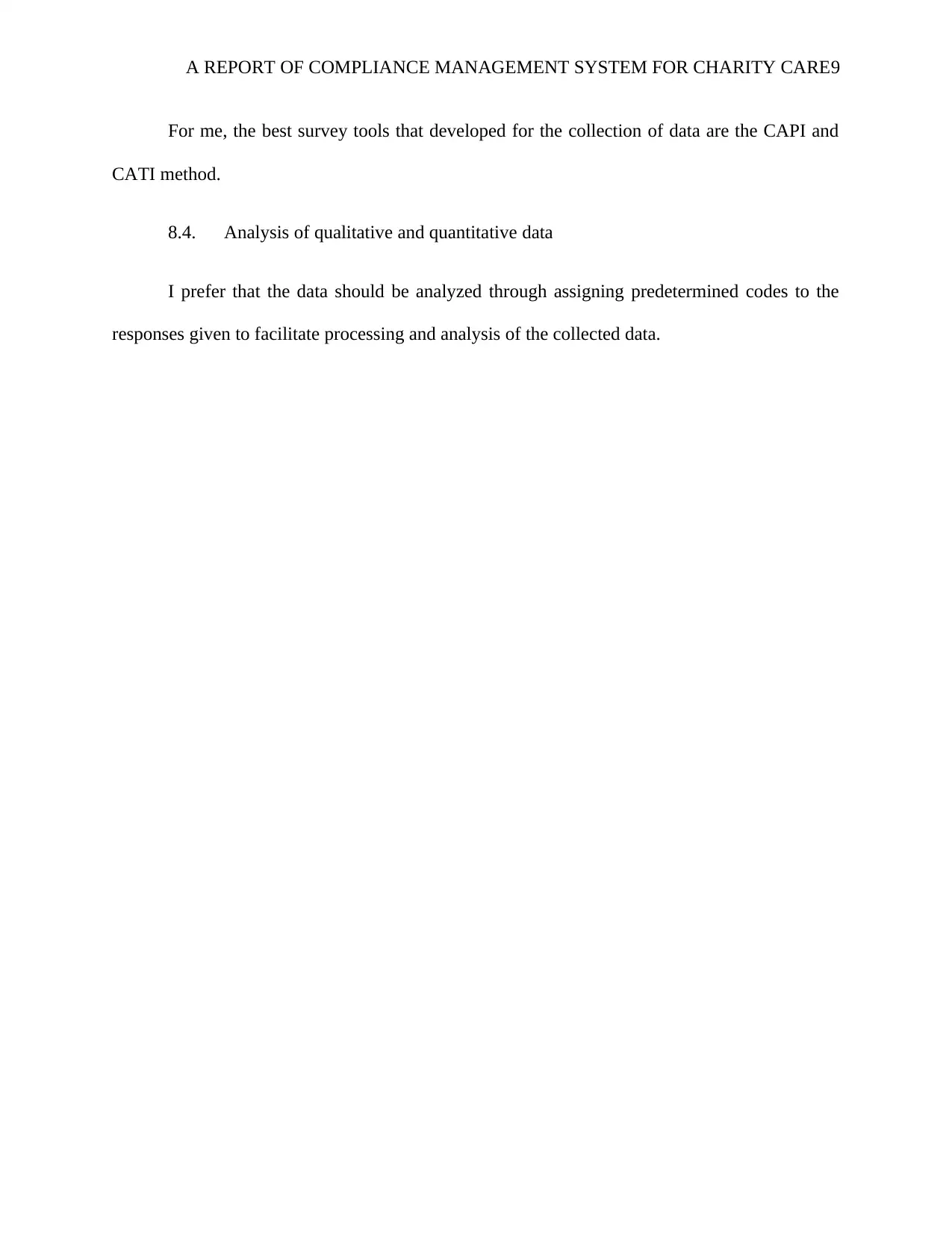
A REPORT OF COMPLIANCE MANAGEMENT SYSTEM FOR CHARITY CARE9
For me, the best survey tools that developed for the collection of data are the CAPI and
CATI method.
8.4. Analysis of qualitative and quantitative data
I prefer that the data should be analyzed through assigning predetermined codes to the
responses given to facilitate processing and analysis of the collected data.
For me, the best survey tools that developed for the collection of data are the CAPI and
CATI method.
8.4. Analysis of qualitative and quantitative data
I prefer that the data should be analyzed through assigning predetermined codes to the
responses given to facilitate processing and analysis of the collected data.
⊘ This is a preview!⊘
Do you want full access?
Subscribe today to unlock all pages.

Trusted by 1+ million students worldwide
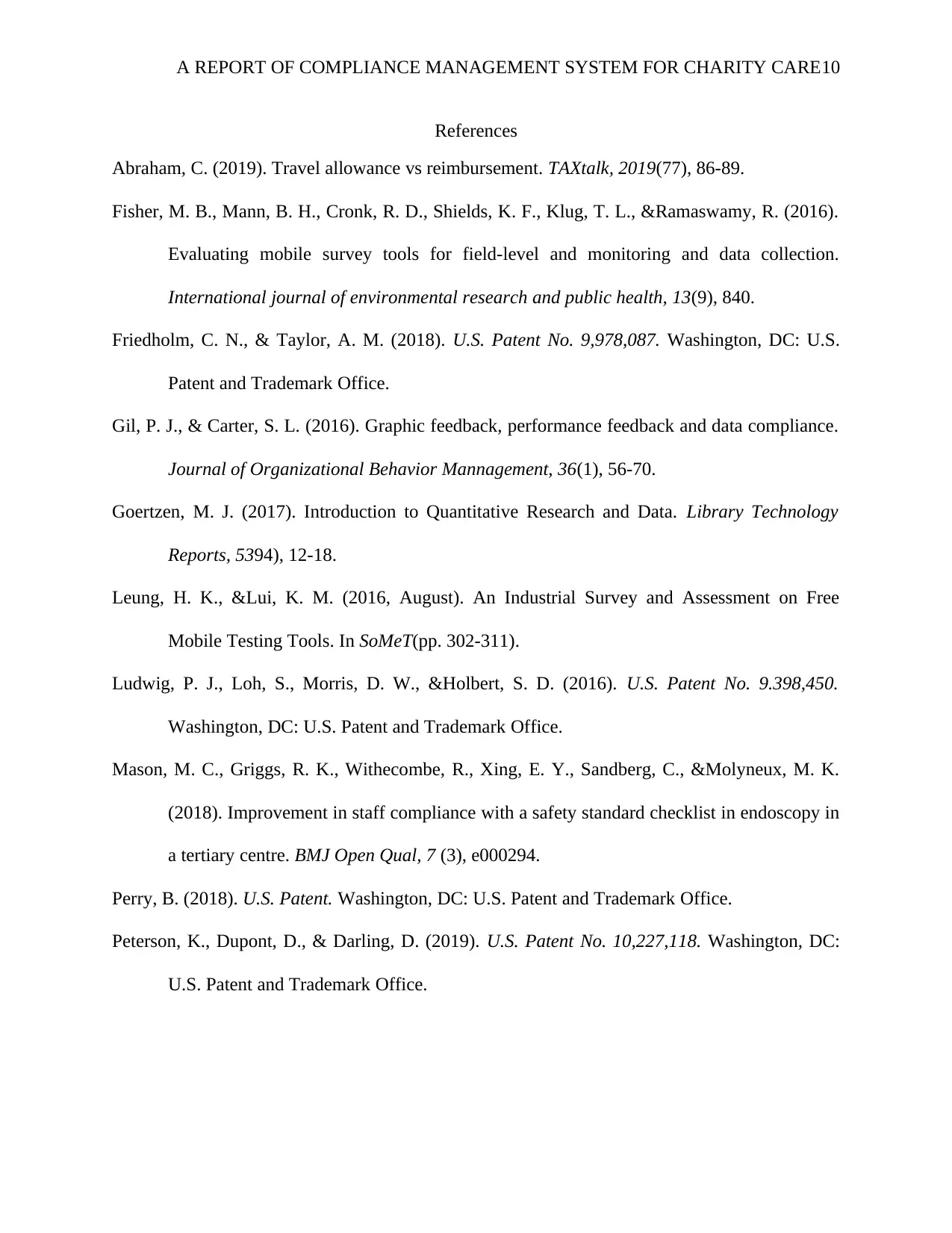
A REPORT OF COMPLIANCE MANAGEMENT SYSTEM FOR CHARITY CARE10
References
Abraham, C. (2019). Travel allowance vs reimbursement. TAXtalk, 2019(77), 86-89.
Fisher, M. B., Mann, B. H., Cronk, R. D., Shields, K. F., Klug, T. L., &Ramaswamy, R. (2016).
Evaluating mobile survey tools for field-level and monitoring and data collection.
International journal of environmental research and public health, 13(9), 840.
Friedholm, C. N., & Taylor, A. M. (2018). U.S. Patent No. 9,978,087. Washington, DC: U.S.
Patent and Trademark Office.
Gil, P. J., & Carter, S. L. (2016). Graphic feedback, performance feedback and data compliance.
Journal of Organizational Behavior Mannagement, 36(1), 56-70.
Goertzen, M. J. (2017). Introduction to Quantitative Research and Data. Library Technology
Reports, 5394), 12-18.
Leung, H. K., &Lui, K. M. (2016, August). An Industrial Survey and Assessment on Free
Mobile Testing Tools. In SoMeT(pp. 302-311).
Ludwig, P. J., Loh, S., Morris, D. W., &Holbert, S. D. (2016). U.S. Patent No. 9.398,450.
Washington, DC: U.S. Patent and Trademark Office.
Mason, M. C., Griggs, R. K., Withecombe, R., Xing, E. Y., Sandberg, C., &Molyneux, M. K.
(2018). Improvement in staff compliance with a safety standard checklist in endoscopy in
a tertiary centre. BMJ Open Qual, 7 (3), e000294.
Perry, B. (2018). U.S. Patent. Washington, DC: U.S. Patent and Trademark Office.
Peterson, K., Dupont, D., & Darling, D. (2019). U.S. Patent No. 10,227,118. Washington, DC:
U.S. Patent and Trademark Office.
References
Abraham, C. (2019). Travel allowance vs reimbursement. TAXtalk, 2019(77), 86-89.
Fisher, M. B., Mann, B. H., Cronk, R. D., Shields, K. F., Klug, T. L., &Ramaswamy, R. (2016).
Evaluating mobile survey tools for field-level and monitoring and data collection.
International journal of environmental research and public health, 13(9), 840.
Friedholm, C. N., & Taylor, A. M. (2018). U.S. Patent No. 9,978,087. Washington, DC: U.S.
Patent and Trademark Office.
Gil, P. J., & Carter, S. L. (2016). Graphic feedback, performance feedback and data compliance.
Journal of Organizational Behavior Mannagement, 36(1), 56-70.
Goertzen, M. J. (2017). Introduction to Quantitative Research and Data. Library Technology
Reports, 5394), 12-18.
Leung, H. K., &Lui, K. M. (2016, August). An Industrial Survey and Assessment on Free
Mobile Testing Tools. In SoMeT(pp. 302-311).
Ludwig, P. J., Loh, S., Morris, D. W., &Holbert, S. D. (2016). U.S. Patent No. 9.398,450.
Washington, DC: U.S. Patent and Trademark Office.
Mason, M. C., Griggs, R. K., Withecombe, R., Xing, E. Y., Sandberg, C., &Molyneux, M. K.
(2018). Improvement in staff compliance with a safety standard checklist in endoscopy in
a tertiary centre. BMJ Open Qual, 7 (3), e000294.
Perry, B. (2018). U.S. Patent. Washington, DC: U.S. Patent and Trademark Office.
Peterson, K., Dupont, D., & Darling, D. (2019). U.S. Patent No. 10,227,118. Washington, DC:
U.S. Patent and Trademark Office.
1 out of 10
Related Documents
Your All-in-One AI-Powered Toolkit for Academic Success.
+13062052269
info@desklib.com
Available 24*7 on WhatsApp / Email
![[object Object]](/_next/static/media/star-bottom.7253800d.svg)
Unlock your academic potential
Copyright © 2020–2025 A2Z Services. All Rights Reserved. Developed and managed by ZUCOL.




